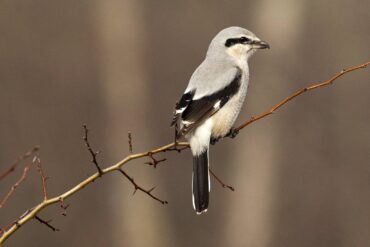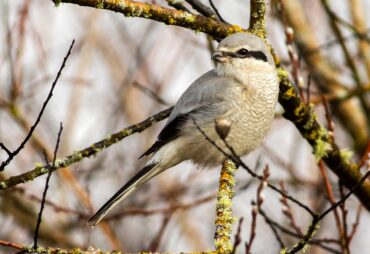
Imagine walking a West Sound trail through an open, wooded area on a crisp day in late fall or winter. A charming black, white and gray bird, slightly smaller than a robin, is perched in a bare tree. Its endearing black-eye mask gives the impression that it’s pretending to be a villain. It appears almost hawk-like as its penetrating gaze surveys the area. Then something unexpected happens — this seemingly harmless bird isn’t looking for late season berries.
Suddenly, it launches into the air and lands on an unsuspecting song sparrow. You watch in horror as the pint-sized predator does the macabre deed of impaling the dead sparrow on a nearby barbed wire fence. You quickly realize that this peculiar bird isn’t merely pretending to be a villain. It is, in fact, a villain! You just entered the world of the northern shrike.
Despite behaving like a bird of prey, the northern shrike is actually a songbird. It breeds in the boreal forests of northern Canada and Alaska and winters in southern Canada and the northern and central United States. It also inhabits northeast Asia.
There are 33 species of shrikes in the world. North America’s other species, the loggerhead shrike, is a close cousin of the northern shrike. This cousin is an uncommon summer resident of Eastern Washington and a rarity in Western Washington.

The northern shrike, while uncommon in Western Washington, has been spotted with greater frequency around West Sound in recent years during the late fall and winter months. Open areas with scattered trees are a shrike’s preferred habitat and offer the best places for finding one. Some known locations include Point No Point County Park and the open areas around Hansville, Clear Creek Trail east of State Route 3 in Silverdale and Theler Wetlands Nature Trails in Belfair. Look for one perched in a small tree, in a shrub or on a fence.
Unlike other songbirds that dine on seeds, berries and small insects, shrikes take a considerably different approach to eating. They have an appetite for large insects, small birds and mammals, and sometimes lizards and frogs. Basically, any creature the norther shrike can snatch up and carry better be vigilant if it doesn’t want to be on this predatory songbird’s menu.
Despite its unimpressive size, the northern shrike is one tough bird. Upon seeing a potential meal, it launches itself from its perch and seizes the hapless songbird or critter, catching it on the ground or in the air. It’s even capable of grabbing prey nearly twice its size and subsequently carrying it to a favorite perch.
In older field guides, the Latin name for northern shrike is lanius excubitor, which literally means “watchful butcher.” Ornithologists recently split the species, now calling the European species the great gray shrike, which kept the “watchful butcher” Latin name. The northern shrike’s Latin name is now lanius borealis, meaning “northern butcher.”
Hence, the northern shrike is often referred to as the “butcher bird.” It earns this nickname for its grisly method of killing prey and storing excess food for later.
Because they lack the talons of actual birds of prey, such as owls, eagles, hawks and falcons, shrikes are unable to squeeze the life out of their victims. Thus, when wrangling a large prey item, such as a rat, the shrike carries it to a perch by holding the victim at the base of the neck, which pinches the spinal cord and paralyzes it. The shrike then vigorously shakes its head back and forth, enduring up to 6 G-forces in the process, until the neck of the unfortunate critter snaps.
Impaling a smaller snack on a thorn or barbed wire also works well for the shrike and serves an additional purpose. What better way to save a meal for later than to skewer it? When the shrike is ready to consume its prey, days or weeks later, the sharp object holds the item in place, allowing the shrike to tear into its flesh with ease, using its hawklike curved beak as a utensil.
The northern shrike is highly territorial and may patrol a hunting area of 360 or more acres, a huge territory for a songbird.
The female selects the nest site, usually in a large shrub or about 8 feet high in a tree. She builds a deep cup of twigs, feathers, moss and grass. The male supplies construction materials. When the female settles in to incubate the clutch of four to nine eggs, only the tip of her tail is visible.
Numbers are stable, but the loss of boreal forest and suitable wintering areas diminish the northern shrike’s nesting and hunting range, which could cause future population declines.
Birds are full of surprises. The northern shrike looks innocent, but a fierce predator lurks behind the mask. Find a viewing near you of nature’s horror show, starring the northern shrike.





























Comments